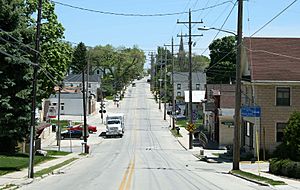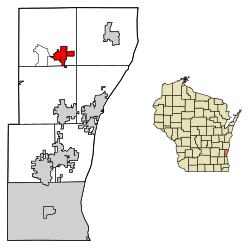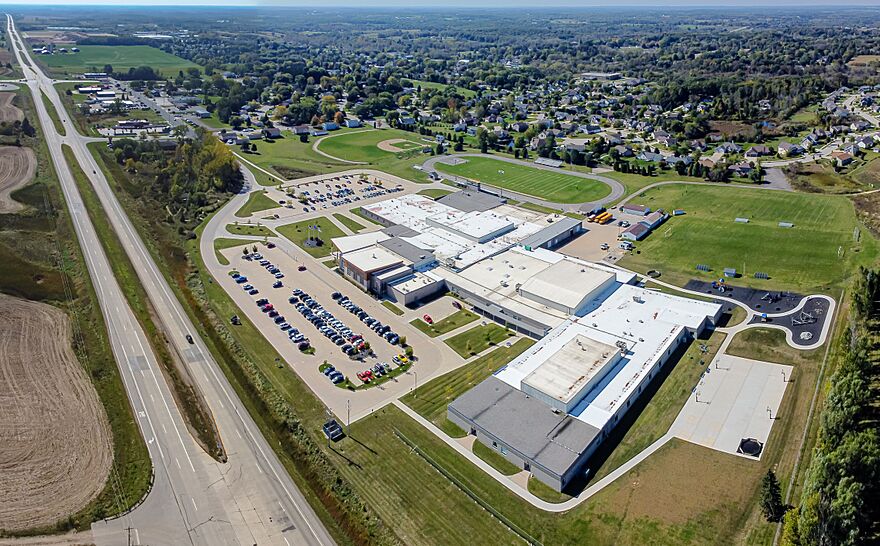Fredonia, Wisconsin facts for kids
Quick facts for kids
Fredonia, Wisconsin
|
|
|---|---|

Looking east in downtown Fredonia
|
|

Location of Fredonia in Ozaukee County, Wisconsin.
|
|
| Country | |
| State | |
| County | Ozaukee |
| Settled | 1840s |
| Incorporated | 1922 |
| Area | |
| • Total | 2.14 sq mi (5.55 km2) |
| • Land | 2.13 sq mi (5.53 km2) |
| • Water | 0.01 sq mi (0.02 km2) |
| Elevation | 896 ft (273 m) |
| Population
(2020)
|
|
| • Total | 2,279 |
| • Density | 1,065.0/sq mi (410.6/km2) |
| Time zone | UTC-6 (Central (CST)) |
| • Summer (DST) | UTC-5 (CDT) |
| Area code(s) | 262 |
| FIPS code | 55-27575 |
| GNIS feature ID | 1565286 |
Fredonia is a small village in Ozaukee County, Wisconsin, in the United States. It is located along the Milwaukee River and is part of the larger Milwaukee metropolitan area. In 2020, about 2,279 people lived there.
Before it became a village, the area was home to the Potawatomi tribe until at least the 1840s. The first European settlers, including people from Germany and Luxembourg, arrived in the 1840s. Fredonia started to grow in the 1870s when a train station was built. It officially became a village in 1922.
Fredonia is near Waubeka, a place famous for Flag Day. The first Flag Day celebration happened there in 1885. Today, Waubeka has the National Flag Day Foundation headquarters and a museum with many patriotic items.
Contents
History of Fredonia
Early Native American Settlements
The land where Fredonia is now was first home to Native American tribes. One of these was the Potawatomi tribe. In 1833, they gave up their land to the United States government through a special agreement called the 1833 Treaty of Chicago.
Many Potawatomi people moved west of the Mississippi River. However, some stayed behind. They were sometimes called "strolling Potawatomi" because they moved around their old lands. One leader, Chief Waubeka, had a winter camp nearby until 1845. Eventually, the Potawatomi who stayed formed the Forest County Potawatomi Community in northern Wisconsin.
How Fredonia Became a Village
Fredonia was first part of the Town of Port Washington. In 1847, it became its own town, named after Fredonia, New York. A post office opened in Fredonia in 1850.
The village really began to grow in 1873. This was when the Chicago, Milwaukee & St. Paul Railway built a train station there. Businesses, grain storage buildings, and homes quickly appeared around the station. The Village of Fredonia officially became a village in 1922. At that time, it had 272 people.
Fredonia During World War II
During World War II, there was a prisoner of war camp called Camp Fredonia nearby. It held 330 German prisoners. In 1945, some of these prisoners worked at a local factory in the village called Fredonia Can Goods, Inc.
Geography and Nature
Fredonia is located at 43°28′6″N 87°57′6″W / 43.46833°N 87.95167°W. The village covers about 2.14 square miles (5.55 square kilometers). Most of this is land, with a small amount of water. Fredonia is in an area shaped by glaciers from the last ice age.
Local Geology
Underneath Fredonia, there are Silurian limestone rocks. These rocks are part of the Racine Dolomite formation. You can see these rocks at old quarries west of the village.
Plants and Animals in Fredonia
Before settlers arrived, the Fredonia area was a thick forest. It had many American beech and sugar maple trees. White cedars grew along the Milwaukee River. Most of this forest was cleared for farming. However, a two-mile stretch of forest still exists along the river near Waubedonia Park.
As more land is developed, wild animals sometimes come closer to human areas. You might see white-tailed deer, coyotes, North American river otters, and red foxes in Fredonia. Many birds, like great blue herons and wild turkeys, also live here.
Fredonia, like many places, faces challenges from invasive species. These are plants and animals that are not native to the area and can harm the local environment. Some examples include the emerald ash borer (an insect), common carp (a fish), and plants like reed canary grass and purple loosestrife.
Population and People
| Historical population | |||
|---|---|---|---|
| Census | Pop. | %± | |
| 1930 | 312 | — | |
| 1940 | 356 | 14.1% | |
| 1950 | 471 | 32.3% | |
| 1960 | 710 | 50.7% | |
| 1970 | 1,045 | 47.2% | |
| 1980 | 1,437 | 37.5% | |
| 1990 | 1,558 | 8.4% | |
| 2000 | 1,934 | 24.1% | |
| 2010 | 2,160 | 11.7% | |
| 2020 | 2,279 | 5.5% | |
| U.S. Decennial Census | |||
What the 2010 Census Showed
In 2010, there were 2,160 people living in Fredonia. There were 827 households, and 614 of these were families. The village had about 1,033 people per square mile.
Most people in Fredonia were White (97.1%). A small number were African American (1.0%) or from other backgrounds. About 1.8% of the population was Hispanic or Latino.
Many households (40.1%) had children under 18 living with them. Most households (59.9%) were married couples. The average household had 2.60 people, and the average family had 3.01 people.
The average age in the village was 35.7 years old. About 27% of residents were under 18. About 9.2% were 65 years or older. There were slightly more males (51.2%) than females (48.8%).
Community and Culture
Fredonia has several places of worship. The Divine Savior Catholic Congregation has the St. Rose of Lima Chapel in the village. They also run a parochial school for students from kindergarten to eighth grade.
Another church in Fredonia is St. John Lutheran Church. It is part of the Missouri Synod.
Local Economy
Fredonia has several businesses that provide jobs for its residents.
| Largest Employers in Fredonia, 2015 | |||
|---|---|---|---|
| Rank | Employer | Industry | Employees |
| 1 | Guy & O'Neill Inc. | Wet wipe manufacturing | 100-249 |
| 2 | Northern Ozaukee School District | Primary and secondary education | 100-249 |
| 3 | Cedar Valley Cheese | Cheesemaking | 50-99 |
| 4 | Badger Paperboard | Paperboard milling | 20-49 |
| 5 | Comprehensive Contracted Services | Manufacturing | 20-49 |
| 6 | Industrial Graphics Corp. | Screen printing | 20-49 |
| 7 | McDonald's | Fast food restaurant | 20-49 |
| 8 | PHD Roof Doctors | Roofing contractor | 20-49 |
Education in Fredonia
Fredonia is part of the Northern Ozaukee School District. This district also serves nearby Newburg and parts of other towns. Students attend Ozaukee Elementary School (K-5), Ozaukee Middle School (6-8), and Ozaukee High School (9-12).
There is also a special school called Riveredge School. It is a tuition-free public charter school for kindergarten through fifth grade. It is located at the Riveredge Nature Center.
The school district is managed by an eight-member elected school board. They meet once a month to make decisions about the schools.
In addition to public schools, Divine Savior Congregation runs a Catholic parochial school in the village. It offers education for students from kindergarten to eighth grade.
Transportation Options
Wisconsin Highway 57 runs through the village, making it easy to travel by car.
For public transportation, Fredonia residents can use Ozaukee County Transit Services' Shared Ride Taxi. This service operates every day of the week. Riders need to call ahead to schedule their pick-up and drop-off times. The taxi service plans its routes based on where people need to go.
The Wisconsin and Southern Railroad has a freight train line that goes through Fredonia. However, there is no passenger train station in the village right now.
Parks and Recreation
Fredonia has seven public parks for everyone to enjoy. These parks have playgrounds, baseball fields, soccer fields, and picnic areas. Some even have an ice-skating rink and an eighteen-hole disc golf course.
Ozaukee County also manages Waubedonia County Park. This park is on the Milwaukee River. It is the only county park that offers overnight campsites. Waubedonia Park also has baseball fields, tennis courts, and places to launch boats.
See also
 In Spanish: Fredonia (Wisconsin) para niños
In Spanish: Fredonia (Wisconsin) para niños


